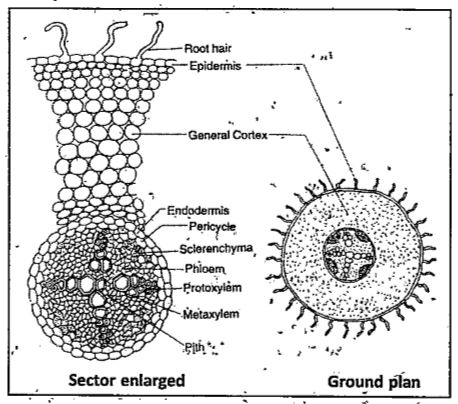Describe the internal structure of a Dicot Root .Solution in Telugu
A. Internal structure of primary dicot root has three zonesepidermis ,cortex , stele .Cortex is bigger than stele.
I . Epidermis :
(1) It is the outermost layer of thin walled rectangular living cells arranged compactly without intercellular spaces.
(2) Cuticle and stomata are absent.
(3) Some epidermal cells (trichoblasts) produce tubular extensions called root hairs. Cells giving rise to root hairs are smaller than other epidermal cells. Epidermis of root is called rhizodermis or piliferous layer or epiblema due to the presence of root hairs.
(4) Root hairs absorb capillary water . The epidermis gives prorection to the inner tissues.

II. Cortex : Ground tissue system extending from epidermis to stele is called cortex .It is differentiated into three parts.
(A) Exodermis :
(1) The outermost layer of cortex with 2 or 3 rows of suberised thick waller cells is called exodermis.
(2) It acts as a protective layer when epidermis is removed.
(3) It prevents the exit of water from cortex.
(B) General cortex :
(1) It is present beneath the exodermis.
(2) It has several layers of loosely arranged thin walled parenchyma. Intercellular spaces are present.
(3) Cells store food materials.
(4) General cortex helps in the lateral conduction of water from epidermis to xylem vessels.
(C ) Endodermis:
(1) It is the innermost layer of cortex .
(2) It is made up of single layer of barrel shaped cells.
(3) Radial and transverse walls of endodermal cells show thickenings due to deposition of lignin and suberin. These are called casparian thickenings. It is characteristic feature of endodermis.
(4) Endodermal cells, present opposite to protoxylem are thin walled without casparian strips. These cells are
called passage cells.
(5) Passage cells help in the entry of water and salts from cortex into stele:
III . Stele : The central conducting cylinder is called stele. It
shows three parts.
(A) Pericycle: It is the outer layer of the stele. It is uniseriate with thin walled rectangular parenchymatous cells. Pericycle gives rise to lateral roots .It also helps in scondary growth.
(B) Vascular bundles:
(1) Xylem and phloem are arranged alternately on separate radii. So vascular bundles are separate or radial. Xylem and phloem conduct water and food materials respectively.
(2) Protoxylem is towards pericycle and metaxylem towards
centre: So xylem is exarch:
(3) Xylem is variable from monarch to octarch (xylem groups 1-8) usually tetrarch (4. xylem groups alternating with 4 phloem bundles). Monarch -Trapa ,Tetrarch Gossypium , Octarch -Castanea .
(4) Cambium is absent.
(5) Parenchyma tissue extending between Xylem and Phloem strands is called conjunctive tissue. It helps in the storage of food materials.
(C ) Pith or Medulla : The central portion of stele is called medulla or pith. It may be completely absent in dicot root. When it is present, it is parenchymatous. It helps in the storage of food and water.
Topper's Solved these Questions
Similar Questions
Give the salient features and importance of chrysophytes.
View SolutionExplain how stem is modified variously to perform different functions.
View SolutionExplain "Rivet popper" hypothesis.
View Solutionनामंकित चित्र की सहायता से द्विबीजपत्री तने के एक संवहन पूल की आन्तरिक रचना का सचित्र वर्णन कीजिए।
View Solutionद्विबीजपत्री पौधे के तने तथा एकबीजपत्री पौधे के तने की आन्तरिक संरचना में कोई चार विभिन्नताएँ जो अनुप्रस्थ काट में दिखायी दें, उनका संक्षेप में वर्णन कीजिए।
View SolutionDescribe secondary growth in a dicot root
View SolutionDescribe the internal structure of a dicot leaf. Diagram not necessary )
View SolutionDescribe the structure of a dicot seed .
View SolutionWhich of the following is not a specific feature in the internal structure of dicot root?
View SolutionDescribe internal structure of dicot root.
OR
Describe internal structure of sunflower root.
View SolutionDescribe internal structure of monocot (Maize) root.
View SolutionDescribe internal structure of (sunflower stem) of young stem of dicot plant.
View SolutionDescribe internal structure of Polyarch Root with figure.
View SolutionDescribe secondary growth in dicot root.
View SolutionDescribe the structure of dicot seed.
View SolutionDescribe the internal structure of a Dicot Root .
View Solution
